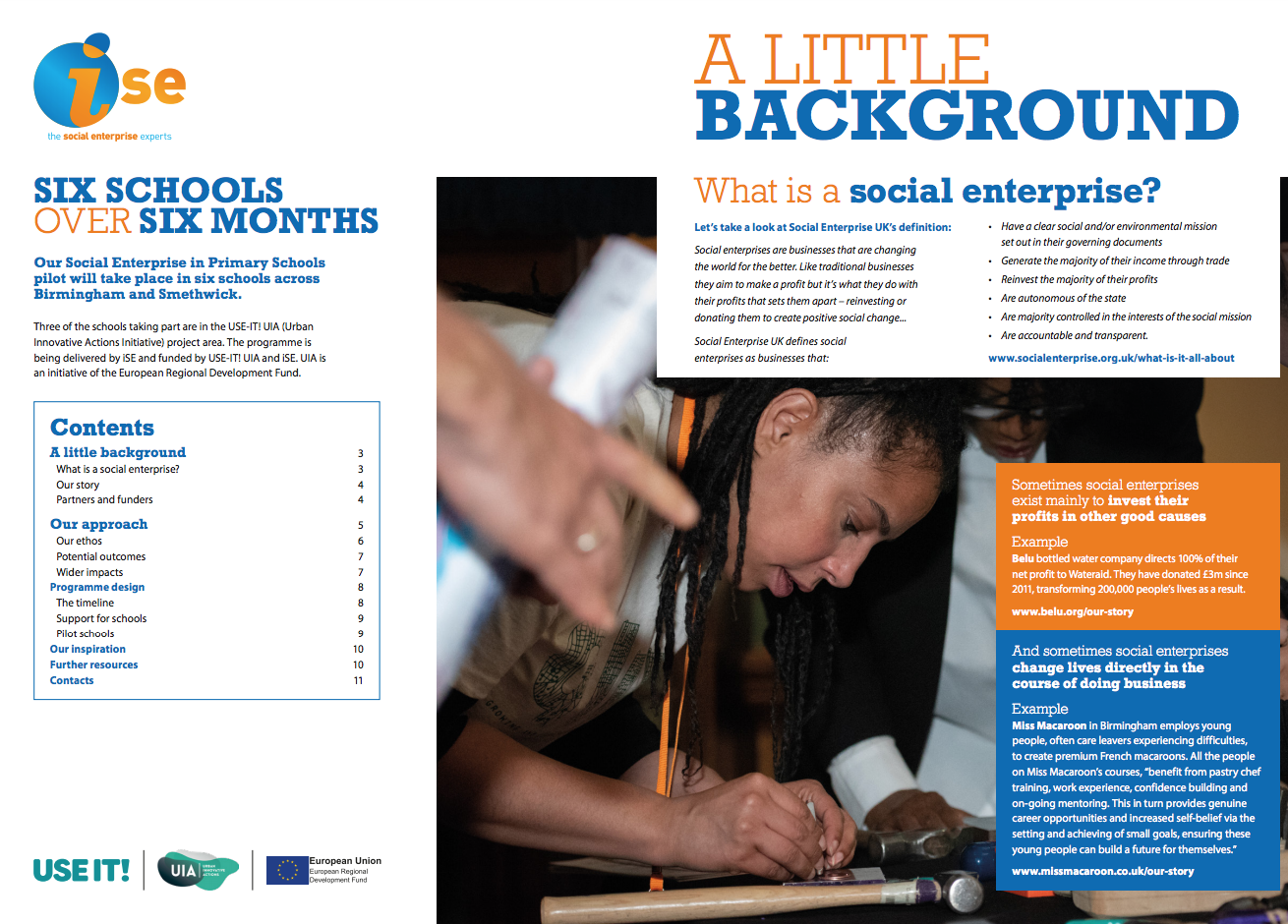Sarah Crawley from iSE and Sally Taylor of Boost Social Impact talk us through the social enterprise pilot undertaken in schools.
How easy was it to get access to a school to work with and how did that come about?
Sarah:It wasn’t easy to get access to school, it took time to develop relationships and trust with each school. The time was underestimated. This has been a pilot and going forward we would give ourselves more time to prepare.
Sally: It was actually quite difficult to get a meeting with schools in the first instance. Thankfully Birmingham Education Partnership were a fantastic support and put us in touch with head teachers who they thought would be interested and up for experimenting with us. We also used personal connections with teachers, learning quickly that cold-calling schools wouldn’t get us anywhere. Without exception, though, when we met with school leadership there was enthusiasm to work with us. Schools came on board understanding that it was a pilot that we would be learning from, and we were asking them to learn with us.
Can you describe your approach to communicating to young people about social enterprise?
Sally: The pilot Social Enterprise in Schools Project (SEiS) provided teachers and children with inspiration, opportunity and support to set up child-led social businesses that raise funds for, or seek to directly improve, a social problem that the school children have identified and wish to creatively and constructively address. The first pilot was delivered by iSE in partnership with myself in the role of Social Impact project manager as part of USE-IT!
The Social Enterprise Challenge pilot involved approximately 400 children and their teachers across six primary schools in the Birmingham area. The children selected for the project were all in years 4, 5 or 6 and whole year groups participated, allowing the project to be embedded in the curriculum where teachers wished to do so – helping to further English (project plans, marketing materials), maths (budgets, income/expenditure reports), art (marketing materials), geography (community surveys and analysis) and design skills (product and service design). The schools told us that to involve all children regardless of background, an in-class programme would be needed, so that is what we designed.
At the very first in-class ‘inspiration and awareness’ session we prioritised helping the children to see their own potential for running a business – doing activities that challenged their preconceptions about what type of person can be a social entrepreneur and showing examples of other social enterprises set up by children. We also got them straight on to ideas generation, brainstorming their ideas about what in their local communities they want to change, who they’d like to help and what weird and wonderful income-generating ideas they have.
What barriers did the young people encounter in developing their ideas, and how have they overcome them?
Sarah: The key barrier young people faced was the same that most people face and this concerns ‘social value’ and how you balance the process of creating a short term business while at the same time creating social value. I think that due to the age of the children, it would be fair to say that the teachers who were leading the sessions also really struggled with the concept of social enterprise as it was mostly not a business model they were familiar with. Interestingly once the model was understood many of the schools’ plan to take the work forward as they recognise the impact of doing business differently.
Sally: The children we worked with were very young but this did not stop them getting stuck in – they were passionate about who they wanted to help (often people experiencing homelessness and isolation, but also their peers in temporary accommodation or who have English as a second language). The biggest barrier to developing the ideas – for the children and the teachers – was confidently understanding the real focus of the business. For example, the concept that businesses could develop a trading model that either did or did not have a link to the social impact they wanted to create was really new and caused confusion. We learnt that we have to do more work to focus first on social impact goals and then on the business side of their social enterprise in order to define each of these more clearly. We’ve worked this into our teacher training and lesson planning for the next iteration.
One school found that their wish to run the project for Year 6 was just too much, with SATS and end of year/leaving assemblies. Our learning is to make sure that any future iteration is focused on junior school years up to Year 5, but not including Year 6. This will also mean there’s the potential for businesses to continue in subsequent years and learning to be shared between year groups.
What is the legacy of the pilot project?
Sally: We were really pleased that we managed to involve so many children in the project. Our hypothesis is that those children now have more awareness of the potential for business to benefit society and will be able to consider that in their own future career choices.
We have been very open about our learning on the pilot and have designed a future programme taking into account the lessons we’ve learned to create teacher training materials and lesson plans. We have a programme ‘ready to go’ but the current challenge is to develop a funding plan. Monetising the programme is unrealistic in the current schools climate, so public funding or other forms of investment are necessary for it to continue. The Scottish Government realise the importance of empowering our children to develop community businesses through schools, and we would like to see the same investment in England.
To find out more about the schools work, please get in touch with Sarah Crawley Sarah.Crawley@i-se.co.uk

